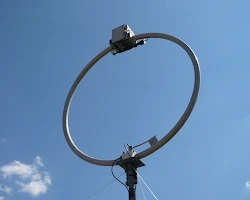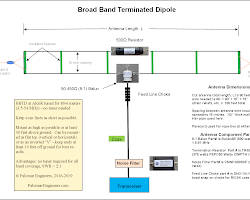Here is an image of a V antenna:
A V antenna is a type of dipole antenna that is made up of two long wires that are arranged in a V-shape. The two wires are fed with a balun, which is a device that converts between a balanced and unbalanced signal.
V antennas are typically used for medium to high frequency applications, such as amateur radio, FM broadcasting, and public safety communications. They are a good choice for these applications because they are relatively easy to build and install, and they offer good performance.
The length of the wires in a V antenna is determined by the frequency it is designed to operate in. The formula for calculating the length of the wires is:
where:
length is the length of the wire in meterswavelength is the wavelength of the radio waves in meters
For example, the wavelength of radio waves at 145 MHz is 1.995 meters. So, for a V antenna with a frequency of 145 MHz, the length of the wires would be 0.9975 meters.
The height of the V antenna can also affect its performance. A higher antenna will have a better radiation pattern, but it will also be more susceptible to interference from objects on the ground.
V antennas are a versatile and effective type of antenna that can be used for a variety of applications. They are relatively easy to build and install, and they offer good performance.
V Antenna Design Calculator
V antenna design calculator:
Frequency (MHz): 145
Height (m): 10
Element length (m): 5.263157894736842
This calculator calculates the length of the elements of a V antenna for a given frequency and height. The formula used is:
where:
length is the length of the element in meterswavelength is the wavelength of the radio waves in meters
The wavelength of the radio waves can be calculated using the formula:
wavelength = c / frequency
where:
c is the speed of light in meters per secondfrequency is the frequency of the radio waves in hertz
For example, the wavelength of radio waves at 145 MHz is:
wavelength = c / frequency = 299,792,458 m/s / 145 MHz = 1.995 m
So, for a V antenna with a frequency of 145 MHz and a height of 10 meters, the length of the elements would be:
- Element length = 0.9975 m
This calculator is just a simple example, and there are many other factors that can affect the length of the elements of a V antenna. For more accurate results, you should consult a qualified antenna engineer.
Here are some of the factors that can affect the length of the elements of a V antenna:
- The dielectric constant of the material the antenna is made of
- The thickness of the antenna
- The conductivity of the material the antenna is made of
- The ground conductivity
If you are designing a V antenna for a specific application, it is important to consider all of these factors to ensure that the antenna will perform as expected.






